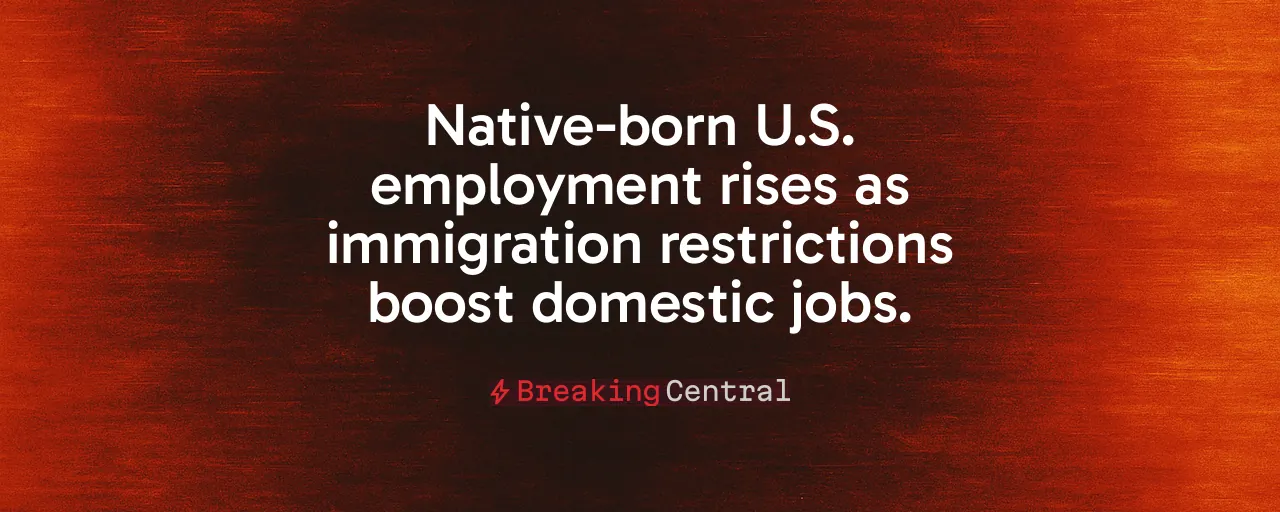A Bold Shift in Job Growth
In the first six months of 2025, the U.S. labor market delivered a striking win for native-born workers. Bureau of Labor Statistics data reveal a gain of two million jobs for citizens, while foreign-born employment fell by 543,000. Administration officials point to this as proof that President Trump's renewed border enforcement and visa restrictions are putting American workers first. The numbers, drawn from the Household Survey, have ignited a fierce debate about immigration's role in the economy.
This shift did not happen by chance. Policies like mandatory E-Verify, expanded deportations, and tighter visa rules have reshaped the labor landscape. For many Americans, especially in low-skill sectors, the change feels like a long-overdue correction. The data also raise questions about sustainability, costs, and unintended ripples across industries. What does this mean for the nation's future?
Prioritizing American Workers
The core idea behind these policies is simple: U.S. jobs are prioritized for U.S. citizens first. Advocates argue that curbing illegal immigration and reducing temporary work visas eliminate unfair competition. Native-born workers, particularly those without college degrees, have long faced wage stagnation. Data from early 2025 show a nearly 2% real wage increase for nonsupervisory roles, a sign that employers are raising pay to attract local talent.
Historical parallels support this approach. After border crackdowns in the late 1990s, low-skill sectors like construction and hospitality saw wage gains for citizens. Surveys from 2025 indicate similar trends, with employers offering higher entry-level pay after losing access to undocumented labor. For communities hit hard by globalization, this feels like a lifeline.
Enforcement Drives Results
The mechanics of this job surge trace back to aggressive enforcement. Nationwide E-Verify mandates force employers to verify worker eligibility, discouraging illegal hires. Stepped-up deportations and physical border barriers deter unauthorized crossings. Visa programs, once a pipeline for low-cost labor, now face stricter quotas favoring high-skill applicants. These measures signal that breaking immigration laws carries consequences.
The impact is clear in industries like agriculture and construction, where native hiring has spiked. Workers in these fields report better job security and bargaining power. However, enforcement is not without hurdles. Courts have challenged some executive actions, and businesses warn of labor shortages. The question remains whether these policies can scale without disrupting supply chains.
Weighing the Trade-Offs
No policy is without costs. Industries reliant on immigrant labor, such as farming and elder care, report unfilled positions. A 2024 report noted that foreign-born workers make up 19% of the labor force, often filling roles natives avoid. Some employers warn that reduced labor supply could drive up prices for food and housing, squeezing consumers. Rural communities, already stretched thin, face staffing gaps in schools and hospitals as immigrant populations decline.
Supporters argue these are short-term pains for long-term gains. Mechanization and higher wages could draw more citizens into these roles over time. The risk of inflation, while real, is seen as a necessary trade-off for restoring economic fairness. The bigger challenge lies in maintaining momentum amid legal battles and lobbying from industries seeking looser rules.
A Broader Economic Vision
Beyond enforcement, the administration is pushing apprenticeships and vocational training to boost native participation. Programs targeting high-school graduates and recovering opioid users aim to fill gaps in trades and manufacturing. These efforts align with a broader goal: rebuilding a self-reliant workforce. By pairing immigration curbs with domestic investment, policymakers hope to create a labor market that rewards citizens first.
Historical cycles of immigration restriction, like the 1920s quotas or the 1986 reforms, show mixed results. Wage gains often come with adjustment costs, but they also spur innovation. The current approach bets that a tighter labor market will force businesses to adapt, whether through automation or better pay. Early data suggest this gamble is paying off, but the full picture will take years to emerge.
Navigating the Road Ahead
The 2025 job numbers are a milestone. Sustaining native employment gains requires balancing enforcement with economic realities. A potential compromise could involve targeted guest-worker programs for agriculture, paired with strict wage protections. Phasing in E-Verify while expanding legal pathways for high-skill workers might ease business concerns without undermining citizens' priorities.
Public support hinges on results. If wages keep rising and jobs stay plentiful, the case for these policies strengthens. But disruptions, like price spikes or labor shortages, could shift the narrative. The administration also contends with legal limits on its authority and the risk of illegal re-entry if deterrence weakens. Clarity and consistency will be key to keeping the public on board.
Ultimately, this moment reflects a choice about national priorities. Putting American workers first means tackling tough trade-offs head-on. The early evidence suggests a path toward greater economic security for citizens, but success depends on execution and adaptability. As the nation watches, the stakes could not be higher.
